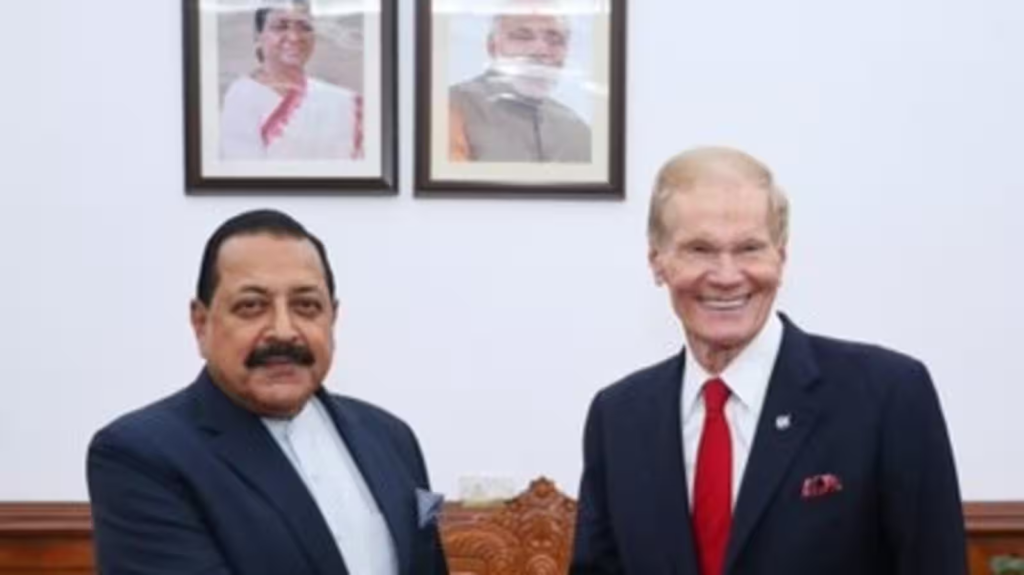
new DElhi, Nov 30
The first space travel by an Indian citizen after Rakesh Sharma’s pioneering journey in 1984 is likely to take place as early as next year. The US will help train and send an Indian astronaut to the International Space Station by the end of 2024, Nasa administrator Bill Nelson announced here on Tuesday.
“The selection of the astronaut will be done by Isro, Nasa won’t be a part of it. Details of the mission are being worked out by Isro,” said Nelson, who is on a multi-city visit to India to enhance Indo-US space cooperation.
“India is a great partner for the US and also a great future partner for the activities of astronauts in space. The US will launch several private landers on the south pole of the Moon next year. But the fact that India was the first to land there deserves congratulation,” the Nasa chief said. Nelson led a high-level US delegation that called on space minister Jitendra Singh and congratulated him for the historic Chandrayaan-3 landing. The Nasa administrator said here that the US was ready to collaborate with India in building the country’s first space station if it so desires. “I think India wants to have a commercial space station by 2040. If India wants to collaborate with us, of course, we will be available.
But that’s up to India,” he said. He also said that Nasa is ready to plan an interplanetary mission with India but it all depends upon Isro.
He also urged space minister Jitendra Singh to expedite the programme related to sending India’s first astronaut aboard a Nasa rocket to the International Space Station (ISS).
On Indo-US collaboration, the Nasa chief said, “We are doing a lot of science together. India, in a joint venture with the US, will launch the most expensive satellite Nasa-Isro Synthetic Aperture Radar (NISAR) in the first quarter of next year. The satellite is expected to be worth nearly $1 billion. NISAR will look at the surface of the Earth and its climate. It will measure any change in its surface – land or water – or any movement in ice mass. This will be very important information as NISAR will give a three-dimension model and tell us exactly what is going to happen on our planet. And this data will be available to all on the Nasa website.”
Nasa is also identifying an opportunity in private astronaut missions for Indian astronauts. Nelson, who is also scheduled to visit Mumbai for a meeting with business leaders in the space sector, took forward the talks that PM Narendra Modi and US President Joe Biden had agreed on earlier this year to launch a two-week joint India-US Space flight next year.
The 14th Nasa administrator is a former US senator from Florida and flew to space on board the Columbia shuttle 38 years ago.
“I saw India twice earlier. The first time I saw India was from space, the entire country in one go in January 1986. I saw Sri Lanka first and as I moved my eyes upward, I could see the entire India. Then I saw the Himalayas at the top of the country that looked like heaven,” he said.
On his excitement to meet cosmonaut Rakesh Sharma, the Nasa chief said, “I am going to Bengaluru tomorrow and I have the pleasure to meet my ‘old friend’ Rakesh. I met Rakesh in April 1991 before the Soviet Union broke apart. Rakesh and I hit it out. I’ve spoken to him over the phone several times,” the Nasa chief said.
On India signing the Artemis Accord, Nelson said, “Till now, 32 nations have signed the accord for peaceful use of space. It will help maintain safety (of space assets), come to the rescue of each other, peaceful purposes in space, respect each other’s activities in space and not interfere.”
Nelson was the second sitting member of the US Congress to fly to space, after Senator Jake Garn. “Our astronauts were skipping a heartbeat when they exerted in space.
So, I did an experiment on a treadmill. I ran 20 minutes on the treadmill and checked a recorder attached to the treadmill. But to my surprise, the recorder was not working. So, I ran 20 more minutes to get it recorded, which means I covered half of the world running (Columbia was circling Earth in roughly 93 minutes).”


























